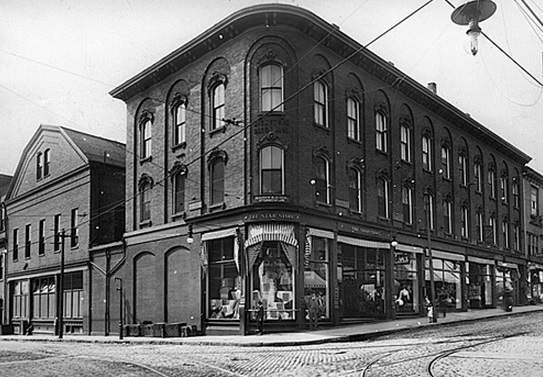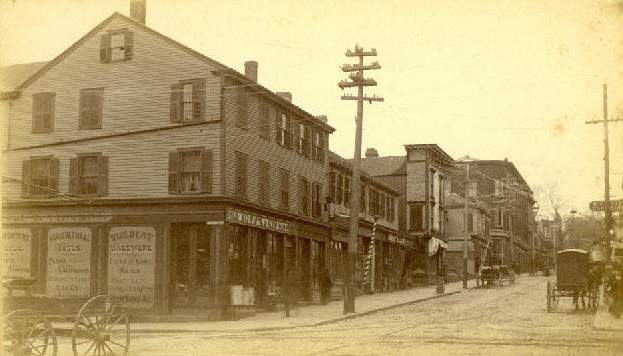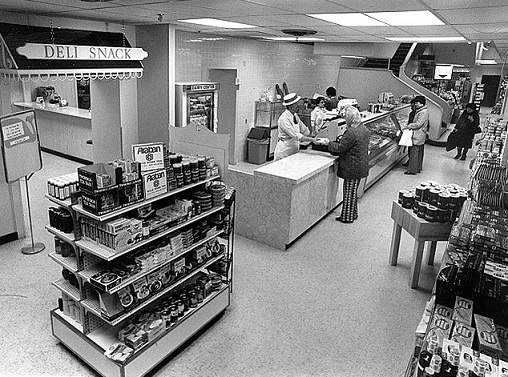Who Remembers…Star Store?
Here is another installment in our Who Remembers? series. You can browse previous articles by using the search bar on the right. These articles are strolls down memory lane. In some cases the buildings, but new businesses have replaced them. In other instances, the buildings or even the properties have been razed. Instead of a building, it may be a TV show, personality, or commercial that no one longer exists. Either way, it can’t stop us from taking the Memory Lane stroll!
As always we would rather this be a discussion. No one knows this area better than those who grew up here! Please, leave constructive criticism, feedback, and corrections. We’d love to hear your anecdotes. Please share!
___________________________________________________________
Fourth Street; Thomas Knowles & Company
Once upon a time, before Purchase Street was named so, it was called 4th Street. It was primarily residential, had a rather large park with gardens and was lined with elm trees. As more and more revenue from Whaling entered the city, business “sprawl” spread north. The first three streets were primarily service streets – businesses that served whaling, i.e. coopers, carpenters, wrights, smithies, customs, the Seamen’s Bethel, Mariner’s home, brothels, etc. The first available street for residents to go shopping or be entertained at was Fourth Street and Purchase Street – East of Union Street- was born circa 1834.
One of the very first dry goods stores on Purchase Street to open was artist William Bradford’s at 16 Purchase Street in 1845. Another merchant, who saw the great potential of Purchase Street was one Thomas Knowles (1803-1877). He and his brother, John Pepper formed a partnership in 1835, T.& J.P. Knowles producing clothing.

Their cousin Joseph Knowles entered the picture and they opened a store on the Northwest Corner of Union and Purchase Street called Thomas Knowles & Company in 1844 – likely the very first establishment to sell dry goods on the street. In addition to dry goods, they sold groceries, provisions and were also agents for over a dozen whaling vessels.
The buildings of note by the 1860s were Liberty Hall, the granite North Congregational Church, the Cummings Building and the Wing’s Building – which was the precursor to Wing’s Department Store and Wing’s Court. More and more businesses popped up on Purchase Street and it became the premier shopping destination.
New Bedford Dry Goods Company
Back to Thomas Knowles & Company – they operated their store with their sons until 1894. Here there is a lacuna in the timeline of the building’s history. When it appears next, it’s New Bedford Dry Goods headed by president Asa A. Mills, which opened to wholesalers on October 8, 1898 with a sales force of 20 people. This store claims to be the site of the very first escalator in the country – in spite of the fact that the Guinness Book of World Records lists Coney Island as having the first.
The one-story building and its basement consisted of a modest 15,000 sq. ft., but its popularity by 1915 meant a ten-fold expansion: they increased their workforce to 300 and took over adjacent buildings to the tune of 150,000 sq. ft. By 1918 it opened to the public, needed an elevator because it expanded upward, and even added a roof garden. New Bedford Dry Goods aka the Star Store became the shopping destination.
Slew of Factoids – Credit plates, carillons, pneumatic tubes
Coincidentally, a lady named Mary Dorothy Cox was selling candies out of the New Bedford Dry Goods Store in 1925.

It had a deli, clothing department, jewelry, cosmetics, pet center, and more. In 1952, Star Store jumped on the bandwagon of “merchant cards”, the precursor to credit cards with a metal card called a “credit plate.” Sometime in the 1960s they built a carillon, which was an automatic music “machine” that consisted of bells that were struck electronically. Star Store’s carillon was a favorite around Christmas time when it belted out Carols and popular Christmas tunes.
A “first” claim for Star Store was that it was the first store in the country to utilize pneumatic tubes which used small containers to send bills and receipts. While it was surely used for practical reasons, it had a real promotional value in drawing in local children.
Musical businesses
Star Store was purchased in 1969 by Boston department store Gorin’s, who intended to keep it as it was. In 1976, a 300-year-old, archaic Blue Law stated that business had to be closed on Sunday. Star Store bucked the law as did Kresge’s further downtown Purchase Street and Golub’s Furniture.
In 1983, Almy bought the Star Store from Gorin’s and opened another Star Store in Fairhaven in the old King’s Department Store where Shaw’s Supermarket is/was now in Berdon Plaza. King’s Department store had a run as a Zaire’s and Ames as well.
Almy’s was purchased by Stop & Shop in 1985 who held a liquidation sale (at the New Bedford site) before closing the doors permanently on January 12, 1985. In November, it re-opened as Stuart’s employing 175 people. Continuing the theme of musical businesses Stuart’s closed its doors in 1987, and moved to the North End. The building was officially vacant and began to deteriorate to the point that the facade was falling onto the sidewalks and street and the city had to erect a covered walkway. Thieves began to strip the building of its copper flashing.

The building was supposed to be the Bristol Hotel, but never materialized. 1989 Hotel Properties paid a little more than $2 million for the building and planned on spending $8 million to turn it into a 117 room hotel. Didn’t happen. In 1990 it was to be turned into a Sheraton hotel that included 14,000 sq ft of retail space…didn’t happen. In 1992 Building was foreclosed on by New England Federal Savings Bank as the owners filed for bankruptcy.
In 1995 the city took over as $700,000 was owed in back taxes and handed control over to the New Bedford Redevelopment Authority. With the influence of Senator Mark Montigny, Governor Paul Cellucci granted the city $32 million in 1998 to renovate a three block area with $16.6 million dollars set aside for the Star Store building. A deal was struck between the city and Sakonnet Properties Inc. who would give the city the Coffin Building which was actually two buildings adjacent to the Star Store. The city in turn forgave $376,000 in back taxes and footed the $500,000 bill to repair the facade.
The rest as they say – is history.
ngg_shortcode_0_placeholder